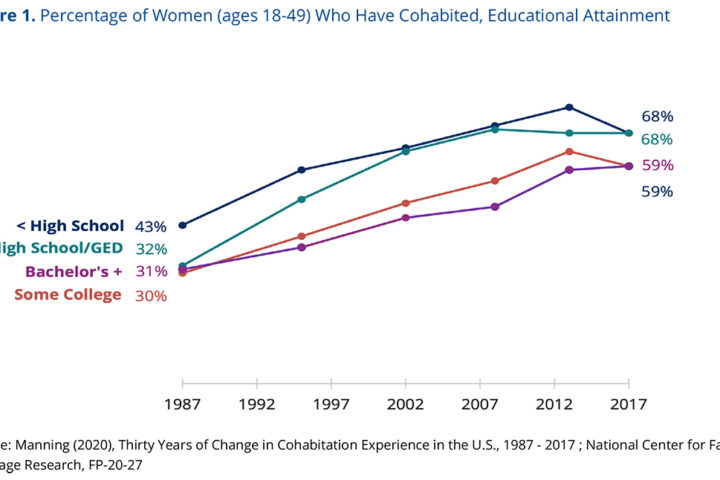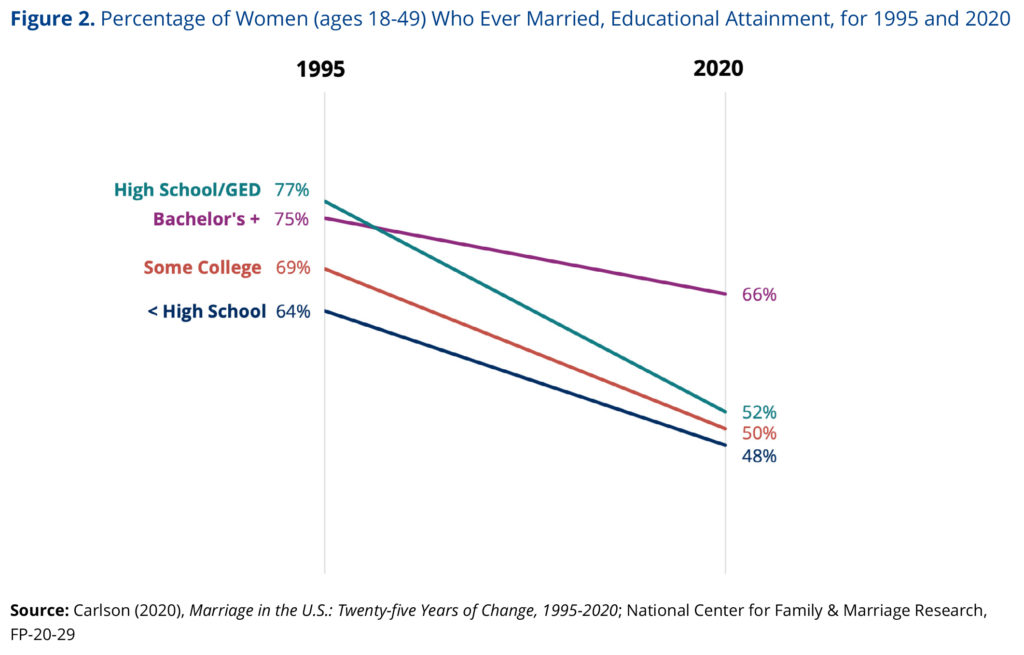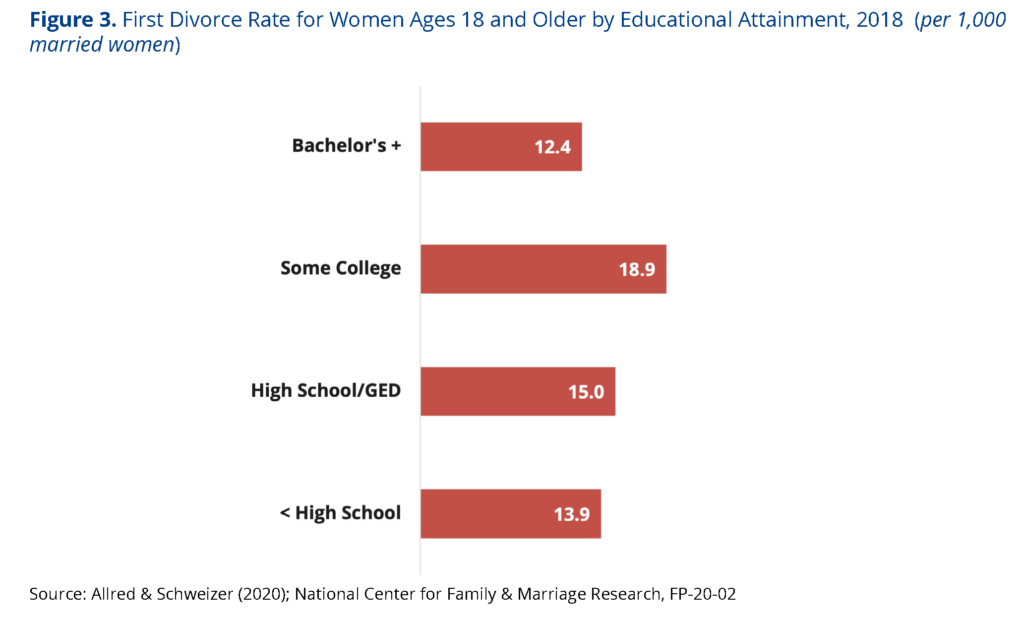1. Coontz, S. (2016). The way we never were: American families and the nostalgia trap. Hachette UK.
2. Manning, W. D. (2020). Thirty years of change in cohabitation experience in the U.S., 1987-2019. Family Profiles, FP-20-27. Bowling Green, OH: National Center for Family & Demographic Research. https://doi.org/10.25035/ncfmr/fp-20-27
3. Sassler, S., & Miller, A. (2017). Cohabitation nation: Gender, class, and the remaking of relationships. Univ of California Press.
4. Sassler, S., & Lichter, D. T. (2020). Cohabitation and marriage: Complexity and diversity in union-formation patterns. Journal of Marriage and Family, 82(1), 35-61.
5. Payne, K. K. (2019). Median age at first marriage, 2017. Family Profiles, FP-19-06. Bowling Green, OH: National Center for Family & Marriage Research. https://www.bgsu.edu/ncfmr/resources/data/family-profiles/payne-median-age-first-marriage-fp-19-06.html.
6. Allred, C. (2019). Marriage rate in the U.S.: Geographic variation, 2018. Family Profiles, FP-18-22. Bowling Green, OH: National Center for Family & Demographic Research. https://doi.org/10.25035/ncfmr/fp-19-22.
7. Manning, W.D., Smock, P. J., & Fettro, M. N. (2019). Cohabitation and marital expectations among single millennials in the US. Population Research and Policy Review, 38(3), 327-346.
8. Arocho, R. (2019). Changes in expectations to marry and to divorce across the transition to adulthood. Emerging Adulthood, doi:10.1177/2167696819879008.
9. Härkönen, J. (2014). Divorce: Trends, patterns, causes, consequences. The Wiley-Blackwell Companion to the Sociology of Families. Chichester: John Wiley & Sons, 303-322.
10. Avellar, S., & Smock, P. J. (2005). The economic consequences of the dissolution of cohabiting unions. Journal of Marriage and Family, 67(2), 315-327.
11. Rhoades, G. K., Kamp Dush, C. M., Atkins, D. C., Stanley, S. M., & Markman, H. J. (2011). Breaking up is hard to do: The impact of unmarried relationship dissolution on mental health and life satisfaction. Journal of Family Psychology, 25(3), 366-374.
12. Seltzer, J. A. (2019). Family change and the changing family demography. Demography, 56(2), 405-426.
13. Manning, W. D., & Smock, P. J. (2005). Measuring and modeling cohabitation: New perspectives from qualitative data. Journal of Marriage and Family, 67(4), 989-1002.
14. Cohen, P. N. (2015). The family: diversity, inequality, and social change. New York Etc.: W. W. Norton.
15. Baker, E. H. (2014). Socioeconomic status, definition. In The Wiley Blackwell Encyclopedia of Health, Illness, Behavior, and Society (pp. 2210-2214). Hoboken, NJ: Wiley-Blackwell.
16. Schneider, D. (2011). Wealth and the marital divide. American Journal of Sociology, 117(2), 627-667.
17. Manning, W. D., Brown, S. L., & Payne, K.K. (2014). Two decades of stability and change in age at first union formation. Journal of Marriage and Family, 76(2), 247-260.
18. Sassler, S., Michelmore, K., & Qian, Z. (2018). Transitions from sexual relationships into cohabitation and beyond. Demography, 55(2), 511-534.
19. Stanley, S. M., Rhoades, G. K., & Markman, H. J. (2006). Sliding versus deciding: Inertia and the premarital cohabitation effect. Family Relations, 55(4), 499-509.
20. Guzzo, K.B. (2020). A research brief on prospective marital expectations among cohabitors with initial marital intentions. Journal of Family Issues, doi:10.1177/0192513X20909145.
21. Parker, E. (2020). Gender differences in the marital plans and union transitions of first cohabitations. Popular Research and Policy Review, 1-22.
22. Vespa, J. (2014). Historical trends in the marital intentions of one-time and serial cohabitors. Journal of Marriage and Family, 76(1), 207-217.
23. Copen, C. E., Daniels, K., & Mosher, W. D. (2013). First premarital cohabitation in the United States: 2006-2010 National Survey of Family Growth (No. 64). US Department of Health and Human Services, Centers for Disease Control and Prevention, National Center for Health Statistics.
24. Lamidi, E. O., Manning, W.D., & Brown, S. L. (2019). Change in the stability of first premarital cohabitation duration in the United States. Demography, 56(2), 427-450.
25. Mernitz, S. E. (2018). A cohort comparison of trends in first cohabitation duration in the United States. Demographic Research, 38(66), 2073-2086.
26. Kuo, J. C. L., & Raley, R. K. (2016). Diverging patterns of union transition among cohabitors by race/ethnicity and education: Trends and marital intentions in the United States. Demography, 53(4), 921-935.
27. Kamp Dush, C. M., Jang, B., & Snyder, A. R. (2018). A cohort comparison of predictors of young adult union formation and dissolution in the US. Advances in Life Course Research, 38, 37-49.
28. Eickmeyer, K. J. (2019). Cohort Trends in Union Dissolution during Young Adulthood. Journal of Marriage and Family, 81(3), 760-770.
29. Addo, F. R. (2014). Debt, cohabitation, and marriage in young adulthood. Demography, 51(5), 1677-1701.
30. Sassler, S., & Miller, A. M. (2011). Class differences in cohabitation processes. Family Relations, 60(2), 163-177.
31. Addo, F. R., Houle, J. N., & Sassler, S. (2019). The Changing Nature of the Association Between Student Loan Debt and Marital Behavior in Young Adulthood. Journal of Family and Economic Issues, 40(1), 86-101.
32. Gibson-Davis, C., Gassman-Pines, A., Lehrman, R. (2018). “His” and “hers”: Meeting the economic bar to marriage. Demography, 55(6), 2321-2343.
33. Torr, B. M. (2011). The changing relationship between education and marriage in the United States, 1940-2000. Journal of Family History, 36(4), 483-503.
34. Allred, C. A. (2018). Marriage: More than a century of change, 1900-2016. Family Profiles, FP-18-17. Bowling Green, OH: National Center for Family & Marriage Research. https://doi.org/10.25035/ncfmr/fp-18-17.
35. Schweizer, V. (2020). First marriage rate in the U.S., 2018. Family Profiles, FP-20-01. Bowling Green, OH: National Center for Family & Marriage Research. https://doi.org/10.25035/ncfmr/fp-20-01
36. Schwartz, C. R. (2013). Trends and variation in assortative mating: Causes and consequences. Annual Review of Sociology, 39, 451-470.
37. Schneider, D., Harknett, K., & Stimpson, M. (2018). What explains the decline in first marriage in the United States? Evidence from the panel study of income dynamics, 1969 to 2013. Journal of Marriage and Family, 80(4), 791-811.
38. Shafer, K., & James, S. L. (2013). Gender and socioeconomic status differences in first and second marriage formation. Journal of Marriage and Family, 75(3), 544-564.
39. Kuo, J. C. L., & Raley, R. K. (2016). Is it all about money? Work characteristics and women’s and men’s marriage formation in early adulthood. Journal of Family Issues, 37(8), 1046-1073.
40. McClendon, D., Kuo, J. C. L., & Raley, R. K. (2014). Opportunities to meet: Occupational education and marriage formation in young adulthood. Demography, 51(4), 1319-1344.
41. Copen, C. E., Daniels, K., Vespa, J., & Mosher, W. D. (2012). First marriages in the United States: Data from the 2006-2010 National Survey of Family Growth. National Health Statistics Report, 49. Hyattsville, MD: National Center for Health Statistics. 2012.
42. Allred, C. (2019). High school seniors’ expectations to marry, 2017. Family Profiles, FP-19-11. Bowling Green, OH: National Center for Family & Marriage Research.
43. Campbell, K., & Wright, D. W. (2010). Marriage today: Exploring the incongruence between Americans’ beliefs and practices. Journal of Comparative Family Studies, 41(3), 329-345.
44. Cherlin, A. J. (2004). The deinstitutionalization of American marriage. Journal of Marriage and Family, 66(4), 848-861.
45. Wang, W. & Parker, K. (2014). Record share of Americans have never married. Pew Research Center’s Social & Demographic Trends Project.
46. Muraco, J. A., & Curran, M. A. (2012). Associations between marital meaning and reasons to delay marriage for young adults in romantic relationships. Marriage & Family Review, 48(3), 227-247.
47. Graf, N. (2019). Key findings on marriage and cohabitation in the U.S. Pew Research Center. Retrieved from: https://www.pewresearch.org/fact-tank/2019/11/06/key-findings-on-marriage-and-cohabitation-in-the-u-s/
48. Qian, Y. (2017). Gender asymmetry in educational and income assortative marriage. Journal of Marriage and Family, 79(2), 318-336.
49. Smock, P. J., Manning, W. D., & Porter, M. (2005). ‘Everything’s there except money’: How money shapes decisions to marry among cohabitors. Journal of Marriage and Family, 67(3), 680-696.
50. Schneider, D., & Reich, A. (2014). Marrying ain’t hard when you got a union card? Labor union membership and first marriage. Social Problems, 61(4), 625-643.
51. Schneider, D. Harknett, K., & Stimpson, M. (2019). Job quality and the educational gradient in entry into marriage and cohabitation. Demography, 56(2), 451-476.
52. Smock, P. J., & Schwartz, C. R. (2020). The demography of families: A review of patterns and change. Journal of Marriage and Family, 82(1), 9-34.
53. Manning, W. D., & Cohen, J. A. (2012). Premarital cohabitation and marital dissolution: An examination of recent marriages. Journal of Marriage and Family, 74(2), 377-387.
54. Tumin, D., Han, S., & Qian, Z. (2015). Estimates and meanings of marital separation. Journal of Marriage and Family, 77(1), 312-322.
55. Allred, C., & Schweizer, V. (2020). First Divorce Rate in the U.S., 2018. Family Profiles, FP-20-02. Bowling Green, OH: National Center for Family & Marriage Research. https://doi.org/10.25035/ncfmr/fp-20-02.
56. Killewald, A. (2016). Money, work, and marital stability: Assessing change in the gendered determinants of divorce. American Sociological Review, 81(4), 696-719.
57. Schwartz, C. R., & Gonalons-Pons, P. (2016). Trends in relative earnings and marital dissolution: Are wives who outlearn their husbands still more likely to divorce? RSF: The Russell Sage Foundation Journal of the Social Sciences, 2(4), 218-236.
58. Dew, J. (2011). The association between consumer debt and the likelihood of divorce. Journal of Family and Economic Issues, 32(4), 554-565.
59. Raley, R. K., & Sweeney, M. M. (2020). Divorce, repartnering, and stepfamilies: A decade in review. Journal of Marriage and Family, 82(1), 81-99.
60. Sayer, L. C., England, P., Allison, P.D., & Kangas, N. (2011). She left, he left: How employment and satisfaction affect women’s and men’s decisions to leave marriages. American Journal of Sociology, 116(6), 1982-2018.
61. Teachman, J. (2010). Wives’ economic resources and risk of divorce. Journal of Family Issues, 31(10), 1305-1323.
62. Schweizer, V. J. (2019). First marriage vs. remarriage in the U.S. Family Profiles, FP-19-08. Bowling Green, OH: National Center for Family & Marriage Research. https://doi.org/10.25035/ncfmr/fp-19-08.
63. Brown, S. L., Lin, I. F., Hammersmith, A. M., & Wright, M. R. (2019). Repartnering following gray divorce: The roles of resources and constraints for women and men. Demography, 56(2), 503-523.
64. Connidis, I. A., Borell, K., & Karlsson, S. G. (2017). Ambivalence and living apart together in later life: A critical research proposal. Journal of Marriage and Family, 79(5), 1404-1418.
65. Strohm, C. Q., Seltzer, J. A., Cochran, S. D., & Mays, V. M. (2009). “Living apart together” relationships in the United States. Demographic Research, 21, 177-214.
66. Raley, R. K., Sweeney, M. M., & Wondra, D. (2015). The Growing Racial and Ethnic Divide in U.S. Marriage Patterns. The Future of children, 25(2), 89–109. https://doi.org/10.1353/foc.2015.0014
67. Nguyen, B. M. D., Alcantar, C. M., Curammeng, E. R., Hernandez, E., Kim, V., Paredes, A. D., … & Teranishi, R. T. (2017). The Racial Heterogeneity Project: Implications for Educational Research, Practice, and Policy. ACT, Inc.
68. Bloome, D., & Ang, S. (2020). Marriage and Union Formation in the United States: Recent Trends Across Racial Groups and Economic Backgrounds. Demography, 1-34.
69. Gates, G. (2013). Same sex and different sex couples in the American Community Survey: 2005-2011. The Williams Institute. UCLA School of Law.
70. Herman-Stahl, M., Scott, M., Cox, K. & Vaughn, S. (2021). History and Implementation of the Federally Funded Healthy Marriage and Relationship Education (HMRE) Grants. Marriage Strengthening Research and Dissemination Center. https://mastresearchcenter.org/mast-center-research/history-and-implementation-of-the-federally-funded-healthy-marriage-and-relationship-education-hmre-grants/
71. Ramos-Olazagasti, M. A. Scott, M. E., Blechman, J. & Logan, D. (2021). An Introduction to Program Design and Implementation Characteristics of Federally Funded Healthy Marriage and Relationship Education Grantees. Marriage Strengthening Research and Dissemination Center. https://mastresearchcenter.org/mast-center-research/an-introduction-to-program-design-and-implementation-characteristics-of-federally-funded-healthy-marriage-and-relationship-education-grantees/
72. Scott, M.E. & Huz, I. (2020). An Overview of Healthy Marriage and Relationship Education Curricula. Marriage Strengthening Research and Dissemination Center. https://mastresearchcenter.org/mast-center-research/an-overview-of-healthy-marriage-and-relationship-education-curricula/
73. Friend, D., & Paulsell, D. (2018). Research to Practice Brief. Integrating Marriage and Relationship Education (HMRE) and Employment Services: Design Choices of Two HMRE Grantees. OPRE Report #2018-51. Washington, DC: Office of Planning, Research, and Evaluation, Administration for Children and Families, U.S. Department of Health and Human Services.
74. Friend, D., Zaveri, H., & Feeney, K. (2020). Implementation of Career STREAMS: An integrated employment and healthy relationship program for young adults. OPRE Report #2020-80. Washington, DC: Office of Planning, Research and Evaluation, Administration for Children and Families, U.S. Department of Health and Human Services.
75. D’Angelo, A. V., & Bodenlos, K. (2020). Empowering Families: Implementation of an Integrated HMRE, Employment, and Financial Literacy Program for Low-Income Couples. OPRE Report #2020-61, Washington, DC: Office of Planning, Research and Evaluation, Administration for Children and Families, U.S. Department of Health and Human Services.
76. Zaveri, H., & Baumgartner, S. (2016). Parents and children together: Design and implementation of two healthy marriage program. OPRE Report Number 2016-64, Washington, DC: Office of Planning, Research and Evaluation Administration for Children and Families, U.S. Department of Health and Human Services.
77. Zaveri, H., & Dion, R. (2015). Embedding job and career advancement services in healthy marriage programs: Lessons from two programs in PACT. OPRE Report Number 2015-47, Washington, DC: Office of Planning, Research and Evaluation Administration for Children and Families, U.S. Department of Health and Human Services.
78. National Resource Center for Healthy Marriage and Families. (2013). Promoting Healthy Relationship Skills for Employees: A Guide for Workforce Professionals. Retrieved from: https://www.dibbleinstitute.org/NEWDOCS/reports/NRCHMF_WorkplaceGuide_508_compliant_md_28_kf.pdf
79. Sassler, S., & Lichter, D. T. (2020). Cohabitation and marriage: Complexity and diversity in union‐formation patterns. Journal of Marriage and Family, 82(1), 35-61.







